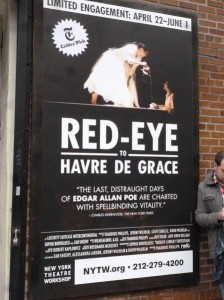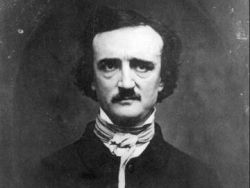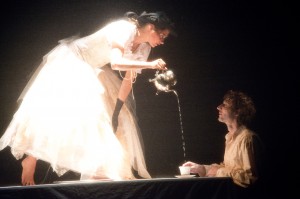 It’s 1849. Edgar Allen Poe, on a lecture tour and traveling by train, grows increasingly anxious when his beloved mother-in-law/aunt hasn’t answered his letters. His late young wife, Virginia, haunts him. RED-EYE TO HAVRE DE GRACE is essentially an exploration of Poe’s baffling last days and a rendering of his brilliant and disturbed mind.
It’s 1849. Edgar Allen Poe, on a lecture tour and traveling by train, grows increasingly anxious when his beloved mother-in-law/aunt hasn’t answered his letters. His late young wife, Virginia, haunts him. RED-EYE TO HAVRE DE GRACE is essentially an exploration of Poe’s baffling last days and a rendering of his brilliant and disturbed mind.
I have taken the train up from Philadelphia to New York, Poe’s thwarted train trip destination, to see how the play has fared since I last saw it. I had discovered it in the Philadelphia Live Arts workshop production in 2005 [review]. Between that iteration and the world premiere at Philadelphia Fringe Festival in 2012 [review], an evolutionary process took place. The earlier play had a narrower focus, and the set had basically consisted of pianos and a single clever convertible contraption.
By ‘12 the show had turned into a broader and deeper exploration of Poe. There was a markedly developed musical presence. The more realized scenic design, including the deft handling of expanded transformational set pieces, still managed to retain a desirable in-process, unfinished look. There was a new Poe and a new Virginia. The lighting, songs, spoken word, atmospheric sounds, supertitles, and continual physical movement were of a piece. The show had grown up.
After playing Philadelphia and a recent turn in Boston, RED-EYE has landed at New York Theatre Workshop in New York. With the addition of a proscenium and a red curtain trimmed with gold fringe along the bottom, Thaddeus Phillips has transported New York Theatre Workshop’s stage back to the 19th century for this production.
 The show hasn’t changed much since the ‘12 Philadelphia version. The sophisticated design still comes off as incidental things coming and going on an essentially bare stage. The musical score is still great and Jeremy Wilhelm’s voice might be even more wonderful. (I have the CD from ’12 for comparison.) The character of Poe is still played by the remarkably Poe-looking Ean Sheehy, who has grown in the role.
The show hasn’t changed much since the ‘12 Philadelphia version. The sophisticated design still comes off as incidental things coming and going on an essentially bare stage. The musical score is still great and Jeremy Wilhelm’s voice might be even more wonderful. (I have the CD from ’12 for comparison.) The character of Poe is still played by the remarkably Poe-looking Ean Sheehy, who has grown in the role.
But there are differences: Since Philadelphia, it has been trimmed from 120 minutes to a svelte 90. The nature of the Virginia character has changed with the introduction of dancer Alessandra L. Larson in the role. Earlier performers, Charlotte Ford and Sophie Bortolussi, were more ethereal. Bortolussi moved like a wraith, pouring herself around Poe and the set pieces like curling smoke. Larson presents a more assertive and muscular approach—more angular than slithery, she climbs rather than snaking around. Athletic and energetic, she pursues and challenges Poe, where before Virginia was a less aggressive and more haunting and puckish manifestation of his obsession.
Having seen these three RED-EYEs and several of Thaddeus Phillips’s and Lucidity Suitcase Intercontinental’s other works [Flamingo/Winnebago, The Melting Bridge, ¡El Conquistador!, Whale Optics, 17 Border Crossings] I can attest to something about the work, and if you’ve also seen these works and others, you already know this: Most striking is that these are integrated visual, aural, visceral meditations, the antithesis of those basically all-talk plays where you can close your eyes and just listen for twenty minutes at a time without missing anything important.
 Phillips and his collaborators don’t see the stage in a traditional way— that is, as a static place set up in advance and fixed, in which talk happens. Rather, in their philosophy, the space, set pieces, and lighting/media are full dynamic partners with the performers, including musicians. The scenic design continually acts and is acted upon. It enables and obstructs, assembles and dismantles, crossing boundaries between virtual and real.
Phillips and his collaborators don’t see the stage in a traditional way— that is, as a static place set up in advance and fixed, in which talk happens. Rather, in their philosophy, the space, set pieces, and lighting/media are full dynamic partners with the performers, including musicians. The scenic design continually acts and is acted upon. It enables and obstructs, assembles and dismantles, crossing boundaries between virtual and real.
In RED-EYE, along with all the invention, there is a grounding in historical evidence that keeps the audience from flying off into fabrications of its own. Facts pin us to the known realities of what was, and when proof runs out the show drops us deep into the mysterious hallucinatory downward spiral of the tormented poet’s last days. “Inventive” is an overused word that should be saved for theatrical productions like this one. [New York Theatre Workshop, 79 East Fourth Street, New York] April 22-June 1, 2014, nytw.org.
